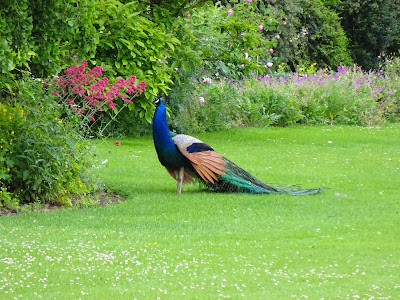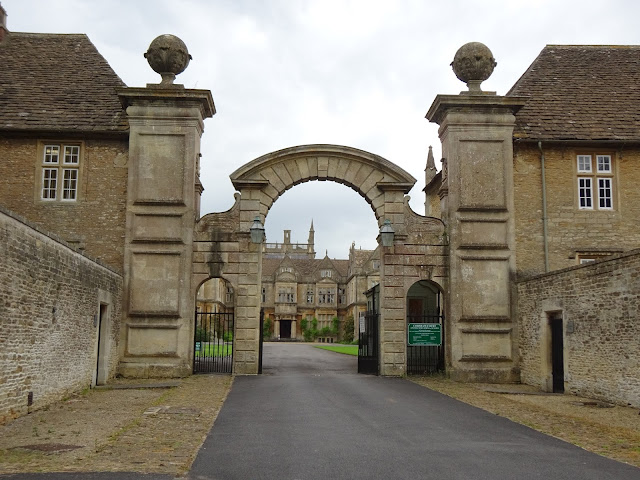I forgot to mention the Queen's Official Birthday a few days ago. She has 2 birthdays, her real one in April and the celebration in June. There are banners and buntings strung throughout villages. Happy Birthday, Mum, rockin' the frog green suit!
Lacock Abbey and the surrounding village were given to the National Trust in 1944 by the Talbot family who still reside in the Abbey. This is one of the most beautiful villages in England, it has a delightful blend of properties that date from the 15th to the 18th-century. I felt like I was wandering into the past, or a movie set. People actually live here? How often have I said this? Everywhere I looked was another thatched and stone cottage. I could revel in Tudor, half-timbered black and white buildings. No TV aerials, overhead cables or yellow lines on its streets spoil the scene.
The village started its life in Saxon times. Norman lords then ruled the area and built a church in honor of St. Cyriac. Lying on the direct London to Bath route, the village prospered. The black and white timbered 15th century wool merchant's house, now "The Sign of the Angel" (named for the image on the coin at the time) , occupies pride of place, but a little uppity for lunch. We chose the tea room.
Lacock ( Lay'-cock) was once a center of the medieval wool trade. You can't fail to be anything other than enchanted.
 |
| Don't...Go...In.... |
 |
| The 15C Wool Merchants House, Now the Angel Inn |
The 14C Tithe Barn was used to collect the tithes , or rent payments, due to the Abbey prior to the dissolution in 1536.
The villagers were tenants, their rent paid in grain and wool fleece, which were collected here.
 |
| Blind House Next to the barn is the 18C Blind House. The Blind House is so called that because it has no windows. Its purpose was to keep drunks and disorderly people overnight. |
 |
| Inside the Lock Up |
 |
| Bay Window at the Angel Inn |
 |
| Very Cool Rain Deflector Board |
 |
| You Should See the Size of These Beams |
So many people sell plants, eggs, jams, herbs, candy... all homemade. You pay through the mail slot or in an "honesty box".
 |
| Lilly Selling Homemade Fudge |
 |
| King John's Hunting Lodge |
King John again, the Robin Hood guy. He hunted in the nearby Saversnake Forest and is reputed to have stayed here. They say this is the oldest building in the village. It's definitely the best tea room ever!
 |
| Fish Cakes and Salad for Lunch |
 |
| Don't Look! |
Peeking out behind the King John's Hunting Lodge Tea Room is Lacock's 11C Norman church - the only church in England dedicated to St Cyriac. Cyriacus was a 3C Christian martyr who was sent to relieve the slaves under the Roman Emperor Diocletian.
He was tortured with hot pitch and beheaded in 304.
 |
| Lacock Abbey |
Even if you don't go inside it's worth a walk around the Abbey. Linda and I snuck in by an open gate, that Linda tried, found unlocked and didn't hesitate to sneak on in. She can now add trespassing to her life's accomplishments.
Lacock Abbey was founded in the 13C as an abbey and a nunnery of the Augustinian order. Following the dissolution of the monasteries in the mid-16th century, Henry VIII sold it for £783, It then became a Tudor home, eventually for the Talbot family in 1750 who has passed it down the generations to present day. It's owned by the National Trust.
Many films and TV productions have been filmed here, including 'Wolf Hall', 'Harry Potter and the Philosopher's Stone' and 'The Other Boleyn Girl'.
 |
| Just Another Day in the Village |
Stop Two of the Beautiful Village Tour is CORSHAM. Another village famed for its surviving historical buildings and traditional village style. The street doubled as 18th century Truro in the new 'Poldark" series, featured in "The remains of the Day' starring Anthony Hopkins and stood in for Meryton "Pride and Prejudice'.
High Street. Peacocks are loose in the town, roaming freely from the grounds of Corsham Court. We saw a large male with full tail feathers fly from wall to wall over the busy road.
Like many prosperous Cotswold towns, Corsham made its wealth from wool and weaving.
 |
| Lots of Nooks |
 |
| A House With a Beehive |
 |
| Row of Weavers Cottages |
The lord of the manor, Corsham Court, Lord Methuen, in order to encourage their settlement, built cottages for the Flemish weavers who came to England in the 17C to escape religious persecution. They found work in Corsham creating high quality wool and cloth.
There's a pub, the Flemish Weaver, established in 1625. A few years ago the pub landlady called in the ghostbusters after she was attacked by an angry spirit.
The ghost tripped her up, sending her flying down the stairs
The drama happened days after she moved into the pub with her husband, an expert in stain glass window repairs.She ended up in the hospital for the day until doctors were satisfied that her suspected fractured skull was, just, a bad bruise.
In another incident the landlady blames the ghost for sending her ironing board crashing to the ground.
The happenings at the pub so shocked the couple that they enlisted the help of a spiritualist who organized a seance of seven people at the pub.
Drama was in store again when a butter plate was flung from the table they were sitting at, smashing on the floor.
Who serves butter at a seance?
Corsham was a manor in the days of the Saxon kings, reputed to have been a seat of Ethelred the Unready. During the 16th century, the manor went to two of Henry VIII's wives, Katharine of Aragon and Katherine Parr. The stunning and eye popping Elizabethan building, dating from 1582, contains a famous collection of paintings and 18C furniture, but we didn't go in. The picture gallery, the largest room, was constructed by Capability Brown, in the 1760’s, to display the collection of Sir Paul Methuen.
The grounds have a stable block and a riding school.
The park was also laid out by Capability Brown, said to represent his most important commission after Blenheim.
The Methuens have lived in Corsham for eight generations since 1745. Corsham Court is now home to James Methuen-Campbell who is 8th heir to the title of Baron. |
| Not Real |
In the grounds of Corsham Court, near the church, there is a large ruin, pretty impressive. It turns out it's a folly, called the Sham Ruin, built around 1798 by John Nash, one of the architects involved in a remodeling, The ruin is supposed to be a castle fragment and incorporates Medieval architectural bits and material from other garden buildings. It includes a mixture of ornate windows, a chimney and the remains of an arch. You mostly look over the wall and ask "What is THAT?"
Hey, why not!
I wonder what my neighbor who complains that my trees block her view would think of this!
 |
| Yes Loud, But So Amazing |
 |
| Corsham Court Friend |
You can see how this scene would be the perfect place to dress in period clothing and go back in time, visually. You can learn how people lived and what was important to them, how their craftsmen took pride in their work. I'm constantly reminded how fortunate it is there are organizations, like English Heritage and the National trust, and like minded people here who make it a priority to appreciate and preserve these places.
For me!
























No comments:
Post a Comment